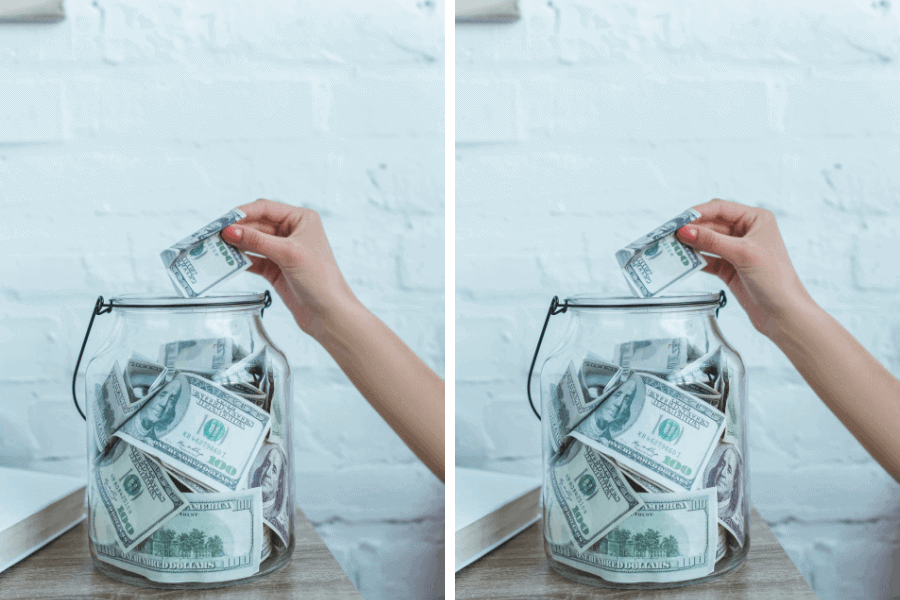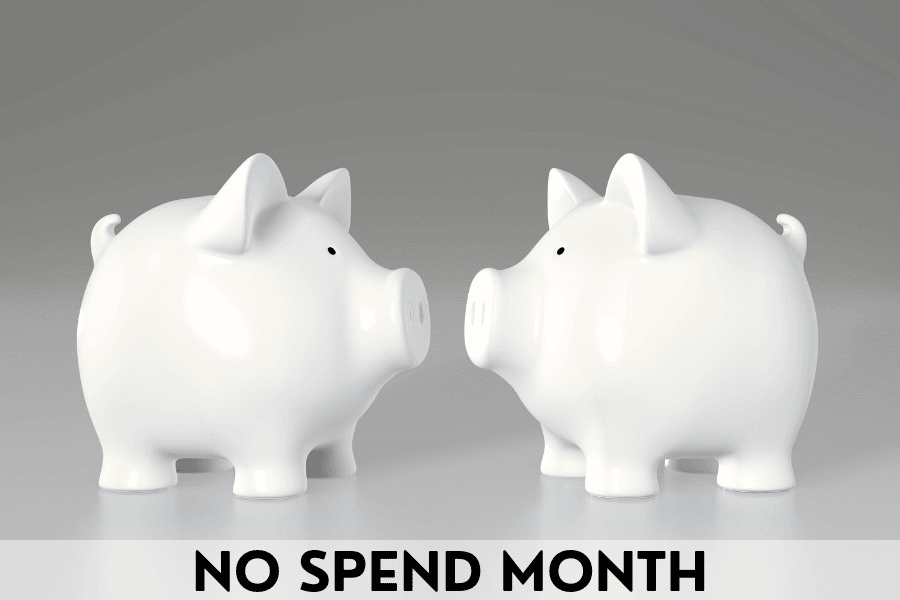Last Updated March 11, 2024 by Davina Kelly
Are you looking for tips to help you navigate a no spend month?
Look no further, in this post I will share the best ways to successfully complete a no spend challenge without feeling deprived.
If you want to stop overspending and improve your money mindset taking part in a no spend month is a good idea.
Incorporating this into my finance routine has helped me to reduce consumerism, pay off debt and increase my savings.
You are going to learn how to complete a no spend challenge including no spend ideas and the other benefits you will gain by embarking on this journey.
After reading this post, you will learn ways to control your spending and improve your overall financial well-being.
This post is all about the best tips for a no spend month.
What Is a No Spend Month?
A no spend month is exactly what it sounds like. It is a savings challenge where you commit to not spending money for a month unless it is for essential expenses.
Not spending any money for an entire month would be difficult so during this period you will focus on your needs such as rent or mortgage payments, food costs, transport and other unavoidable bills. But you will not spend money on unnecessary things like eating out, shopping, etc
The goal of a no spend month is to gain better control over your finances, break bad spending habits, and save money. This challenge can help you build healthy spending habits, increase your awareness of your spending patterns and build financial discipline.
No Spend Month Rules
The great thing about this challenge is that you can set the rules for yourself. You get to decide what you won’t spend money on for the month. For example, are you giving up Starbucks for the month? Or saying no to your monthly girl’s night out? It’s all up to you, however, there are some basic guidelines you should follow.
- Only spend money on essential expenses such as housing costs, food, transport and any bills
- Don’t spend money on wants. This is where the no spend challenge is most effective, you need to resist the temptation to spend money on the things that you want. Wants are anything outside of the essential expenses I listed above. So to be clear this means no spending money on Starbucks, online shopping, eating out, or buying clothes!
Now that we are clear on what a no spend month is and the rules, let’s get into the best tips to help you complete this challenge without giving up.
The Ultimate Guide To a No Spend Month:
1. Review Your Expenses
The first step in preparing for this challenge is to analyse your spending. You need to know where your money is going and what your spending habits are before you commit to freezing your spending for the month.
Start by reviewing your bank statements and credit card statements for the previous months. I recommend looking at the past 3 – 6 months to get a good idea of your spending.
While you are going through your statements you need to categorize your expenditure into essential and non-essential expenses. This will help you to clearly identify the expenses you can allow and the ones you need to omit for the month.
Make a list of your essential expenses and the amounts you plan to spend in each category. If you have a budget that you already follow you can just use that, if not you can create one for this no spend month. Throughout the month track your expenses to keep yourself accountable.
Next, look at your non-essential expenses and pay attention to your spending habits. This presents an opportunity to save and also identify potential areas for improvement. For example, if you can see that you are spending a lot of money on takeaways you can make time to plan your meals throughout the month and going forward.
2. Set an Intention
Before you start your no spend month, establish a clear intention for your challenge. Set a clear goal, whether it is saving for an emergency fund, paying off debt or simply cultivating more mindful spending habits. Having a well-defined intention will keep you motivated and focused throughout the month.
3. Time It Correctly
Timing is everything! I recommend choosing a month that aligns with your lifestyle and financial commitments. Think about things like birthdays, holidays, or planned events that might tempt you to spend. Completing your no spend challenge during a month where you can minimise these pressures will allow you to concentrate on your goals without unnecessary challenges.
4. Move Your Money
To make things even easier for yourself during your no spend month move any money you have left over after paying your bills and essential expenses. You can transfer it to a separate account or a savings account.
This separation will make it more challenging to impulsively spend money because you will be more conscious of your limitations.
5. Plan Ahead
Failing to plan is planning to fail so to avoid failing on your no spend month you need to plan ahead. Create a plan for the essential expenses you are allowed to spend money on during the month.
Start with food costs, this is one of the biggest expenses in every household. Think about your favourite foods for each meal time and use this to create a menu. Don’t forget to include snacks! Before you go grocery shopping take inventory of the food you have at home to save you from spending money on items you don’t need.
Next, make a grocery shopping list for the items you need and stick to it. Read here to learn ways to save money on groceries. It includes a free grocery shopping list that you can use.
Once you have done your grocery shopping you need to make time to plan your meals. Choose one day or a few days throughout the week when you will prepare your meals. This tip is crucial because it will save you time and money.
Also, check to see if you need to buy any household essentials or personal hygiene items. Make a list of anything you need and compare prices online to ensure that you get the best deals before buying them. Having a plan for any upcoming expenses will ensure that you are not caught off guard and will help you to navigate any potential obstacles during this challenge.

6. Avoid Temptation
You can’t completely avoid temptation, but there are some things you can do to make this challenge easier.
If you identify your spending triggers you can take proactive steps to avoid them. For example, if shopping is a trigger you can unsubscribe from tempting newsletters and promotional emails, steer clear of online shopping platforms and reduce social media use.
If you really want to be strict you can leave your cards at home and carry the exact amount of cash you need. This way if you see your favourite chocolates on sale during a grocery trip you won’t be able to buy them. Reducing exposure to temptation will make it easier to stick to your no spend commitment.
7. Track Your Progress
Tracking your progress during your no spend challenge will help to keep you motivated. You can check each day off on a calendar or you can download my free tracker below. When things start to get challenging you can look at your tracker and see how far you have come and realise that you don’t have long left to go.
8. Include Others
Share your plans to complete the no spend month with family and friends and encourage them to join you. Sharing the experience with others not only provides mutual support it will also make the challenge fun and collaborative.
By including others on the journey you can encourage them to have open discussions about financial goals and share tips for overcoming challenges and resisting temptation.
9. Look For Free Entertainment
To stick to your spending challenge you need to cover all bases and that includes finding ways to have fun that don’t involve spending money.
There are plenty of cost-free entertainment options you can explore such as going for a walk while listening to a podcast, movie night with the family or games night with friends. By engaging in these free activities, you can have fun without compromising your financial goals.
10. Plan For Your Savings
It is important to establish a clear plan for the money you save during a no spend month. Whether it goes towards investing or buying a new handbag, having a specific destination for your savings will reinforce the purpose behind you taking part in this challenge.
Related: What To Do With Savings
11. Reflect
Once you have successfully completed the no spend month I recommend taking some time to reflect on your achievements and lessons learned.
Think about how not spending money made you feel and take a minute to celebrate yourself. Acknowledge your hard work and the positive changes you have made throughout the month and consider incorporating some of your newfound healthy money habits into your lifestyle going forward.
You can use this experience to build a solid foundation for smarter money management in the future.
Benefits Of a No Spend Month
Taking part in a no spend challenge offers a multitude of benefits that go beyond financial gains. It can increase your awareness of your spending habits, pinpoint unnecessary spending and develop a more mindful approach to money.
The discipline that you develop during this no spend month can lead to long-term financial benefits such as improving your ability to budget and save money.
Here are some other benefits of a no spend month.
Increase Savings
When you take part in a no spend month you will immediately save money. You will only be spending money on essential expenses so the rest can be saved. These savings can go towards financial goals like debt repayment, investing or personal development.
Improve Spending Habits
Taking a break from spending money will encourage you to reassess your priorities and focus on essential needs rather than impulse purchases. This shift can result in a greater appreciation for the simple things in life and reduce your need for material things for satisfaction.
Create a Positive Money Mindset
Participating in a no spend challenge can significantly improve your money mindset. The intentional decision to stop spending money on non-essential expenses can lead to a deeper reflection on your relationship with money and improve your financial awareness.
Throughout this challenge, you will build discipline and learn to clearly identify the difference between needs and wants. This clarity can lead to more conscious and intentional spending habits in the long run.
Regain Control
Committing to not spending money can help you regain control of your finances by offering a structured approach to sending. This is especially helpful if you have been overspending recently and need some help to reel it back in.
Frequently Asked Questions
What Are The Rules For a No Spend Month?
There aren’t any rules as such for a no spend month. The great thing about this challenge is that you can create your own rules based on your financial circumstances. That said, there are some guidelines that you should follow.
The guidelines are that you should only spend money on needs. As I mentioned earlier in this post that is any essential expenses that are related to your survival. Lastly, don’t spend money on wants, so any non-essential expenses such as eating out will need to be paused for the month.
How Do You Survive a No Buy Month?
To survive a no buy month you need to ensure that you plan ahead, have discipline and are committed to changing your spending habits.
Here are some practical tips to help you navigate and succeed during a no buy month.
- Set clear goals
- Create a budget
- Plan meals and activities ahead
- Identify triggers
- Avoid temptation
- Use cash
- Find free entertainment
- Stay accountable
Final Thoughts
Embarking on a no spend month can help you to transform your relationship with money beyond financial considerations. Committing to pausing spending will allow you to gain valuable insights into your spending habits and distinguish between wants and needs.
It can help you to shift towards intentional spending, reevaluate your priorities and gain a greater appreciation for the non-material aspects of life. This challenge is not only a test of willpower, it is an opportunity for self-discovery and a positive approach to your relationship with money.
I hope you have found this post helpful and now feel inspired and prepared to embark on a no spend month. If you are currently doing the challenge let me know how it is going in the comments.
This post is all about the best tips for a no spend month.
Other Posts You May Like:
How To Stop Spending Money: 12 Best Tips To Avoid Overspending
Financial Minimalism (12 Simple Steps To Live a Rich Fulfilled Life)

Davina Kelly
Hey! I'm Davina, the owner of Davinas Finance Corner. I'm passionate about finding ways to budget, save, earn more money and improve your life. After breaking free from payday loan debt and living paycheck to paycheck I want to share my experience to help other women improve their finances.
